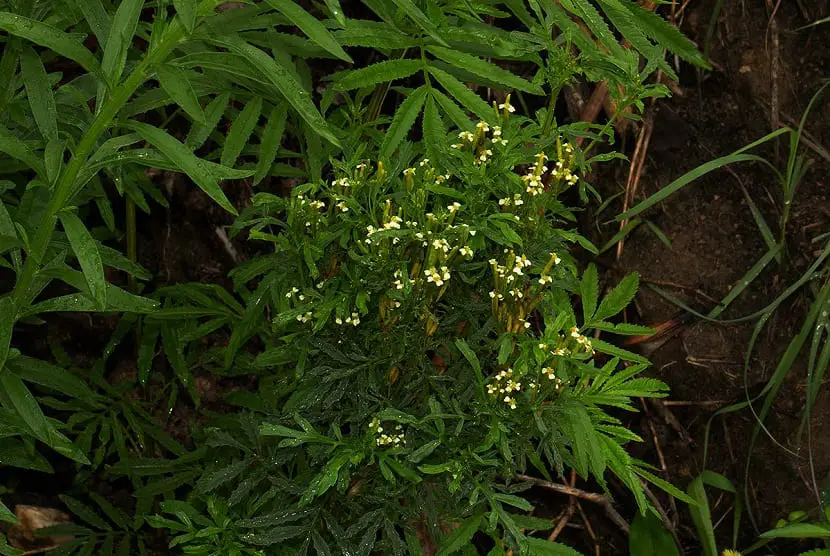
Tagetes minutes is an annual herbaceous plant belonging to the family Asterancea and commonly known by the name of chinchilla or American mint, being native to South America and extending to various regions of the world. It has many uses in traditional medicine and gastronomy.
Characteristics of the Tagetes minuta

This is an erect, woody shrub that can reach two meters in height. Its stems are not branched or they branch in the upper parts of the plant and its texture is ribbed or striated. It is initially green in color and turns brown to yellow after the flowering season.
This species produces clusters of up to 80 tubular flowers, so its inflorescence is very similar to a panicle. The heads have an extension of about 14 mm, surrounded by 5 bracts and each one features about 3 brightly colored flowers. Its fruits are narrow, tubular and usually dark brown in color.
Uses
The whole plant is used for medicinal uses, such as vermifuge, muscle relaxant, aromatic, diaphoretic, diuretic, laxative. It is also used in the treatment of gastritis, parasitic and fungal diseasesrespiratory system infections, in addition to the steam that emanates from its leaves is used to treat headaches, bronchitis, chest infections, it also serves to disinfect the room. Its oil is used in the preparation of perfumes and massage oils.
Externally used to treat hemorrhoids and skin infectionshelping in the treatment of wounds and cuts, so it should be administered on the skin in moderation, especially in those with sensitive skin. It should not be used during pregnancy or when its existence is suspected.
In gastronomy, its leaves are used as a condiment to flavor soups and prepare sauces. The oil extracted from the plant is used to flavor various sweets, ice creams and drinks.
Diseases and parasites
This plant is sensitive to the attack of many parasites, among which are the following:
- Red mitesThese parasitic insects attack the plant mainly when grown in pots at home.
- Aphids: These attack primarily the leaves and flowers of the plant.
- Nematodes: they attack the root system, causing it to enlarge and the consequent loss of nutrient storage capacity.
Planting and propagation

Although its cultivation can be carried out throughout the spring, it is preferable to do it at the end, you should also try to be quite careful in its planting to avoid damaging its roots. For a better result, you must open a hole with a depth that doubles its roots in length.
For its cultivation in pots, prepare a mixture of soil and very fine sand, then place the seedlings or seeds and remember that the soil must remain moist until germination. When you notice that the container where it is planted is no longer adequate due to its dimensions, you must transplant it directly into the ground. Regarding the climate, this plant prefers temperate climatesHowever, it is very resistant to low temperatures. It also tolerates long droughts.
The Tagetes minuta is ideal for large spaces, serves to cover floors, edges and beds. However, and to avoid overgrowth, it is recommended to maintain a distance of approximately 20 cm between the plants. This weed is perfect for gardens, balconies and terraces.
Regarding its propagation, its reproduction happens by seed during the spring season. Place the seeds in a container with a mixture of soil and sand and then you cover it with plastic. Until its germination you should place it in a place where there is little light and whose temperature remains around 18 °. After germination occurs, you can place it in a sunny spot and remove the plastic. In late spring or early summer it can be planted in a pot.
Fertilization plays an important role when planting in pots, so it is recommended to use enough fertilizer at least once every two weeks, applying the fertilizer mixed with the irrigation water. It should contain well-balanced phosphorus, potassium, and nitrogen.particularly during the flowering period.
